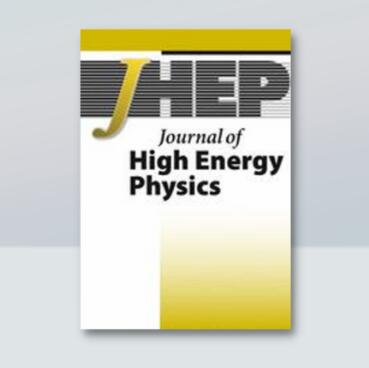关于5d共形物质的希格斯分支的评述
IF 5.5
1区 物理与天体物理
Q1 Physics and Astronomy
引用次数: 0
摘要
在5d scft原子分类的基本构件中,有各种各样的5d双基本共形物质理论。在这项工作中,我们研究了这些模型的希格斯分支和由它们的融合产生的相应分子。为此,我们使用两个互补的独立策略。一方面,对于A型和D型共形物质,我们在IIB中识别了对偶(p, q)膜网,并利用它们来读取相应的磁振子。另一方面,我们利用圆约简并研究了由此产生的4d \( \mathcal{N} \) = 2 SCFTs,给出了它们的希格斯分支的另一种推导,该分支也扩展到E型。本文章由计算机程序翻译,如有差异,请以英文原文为准。
Remarks on the Higgs branch of 5d conformal matter
Among the elementary building blocks in the atomic classification of 5d SCFTs there are 5d bifundamental conformal matter theories of various kinds. In this work we study the Higgs branch of these models and of the corresponding molecules arising from their fusion. To this aim we use two complementary independent strategies. On the one hand for the type A and D conformal matter, we identify dual (p, q) brane webs in IIB and exploit them to read off the corresponding magnetic quivers. On the other hand, we exploit circle reductions and study the resulting 4d \( \mathcal{N} \) = 2 SCFTs, giving an alternative derivation of their Higgs branches which extend also to the E types.
求助全文
通过发布文献求助,成功后即可免费获取论文全文。
去求助
来源期刊

Journal of High Energy Physics
物理-物理:粒子与场物理
CiteScore
10.30
自引率
46.30%
发文量
2107
审稿时长
1.5 months
期刊介绍:
The aim of the Journal of High Energy Physics (JHEP) is to ensure fast and efficient online publication tools to the scientific community, while keeping that community in charge of every aspect of the peer-review and publication process in order to ensure the highest quality standards in the journal.
Consequently, the Advisory and Editorial Boards, composed of distinguished, active scientists in the field, jointly establish with the Scientific Director the journal''s scientific policy and ensure the scientific quality of accepted articles.
JHEP presently encompasses the following areas of theoretical and experimental physics:
Collider Physics
Underground and Large Array Physics
Quantum Field Theory
Gauge Field Theories
Symmetries
String and Brane Theory
General Relativity and Gravitation
Supersymmetry
Mathematical Methods of Physics
Mostly Solvable Models
Astroparticles
Statistical Field Theories
Mostly Weak Interactions
Mostly Strong Interactions
Quantum Field Theory (phenomenology)
Strings and Branes
Phenomenological Aspects of Supersymmetry
Mostly Strong Interactions (phenomenology).
 求助内容:
求助内容: 应助结果提醒方式:
应助结果提醒方式:


